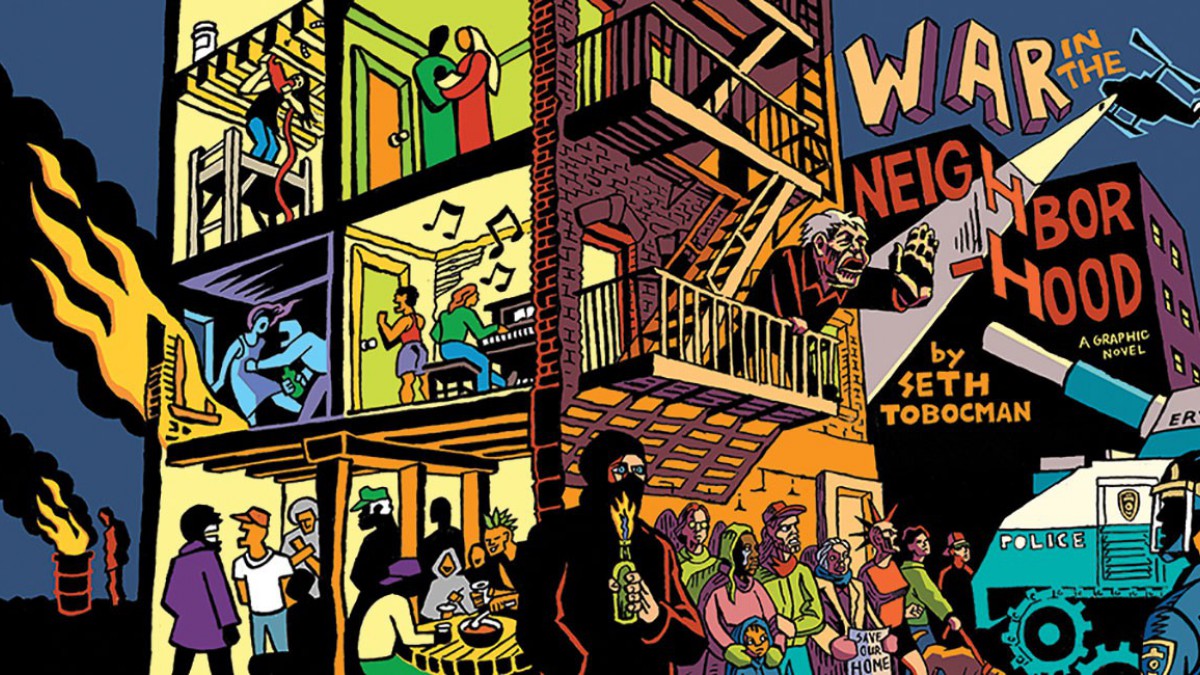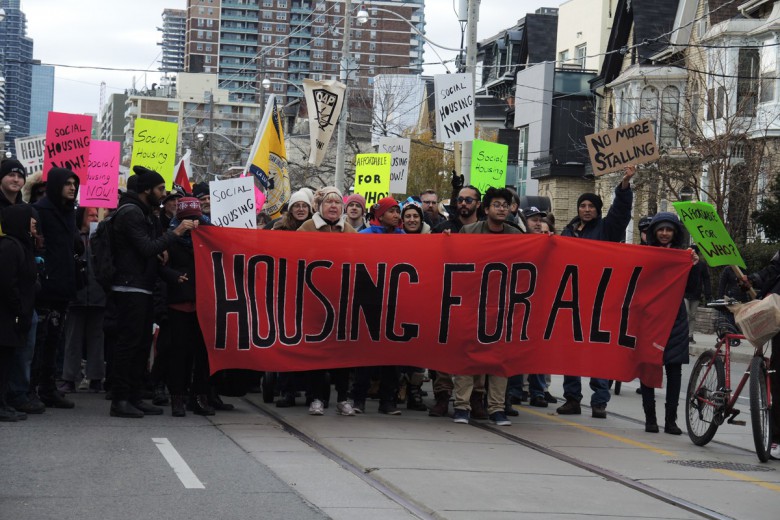By Seth Tobocman
Ad Astra Comix, 2016
I first encountered War in the Neighborhood in 2000, months after Autonomedia Press had published the weighty volume, a black-and-white graphic novel/memoir by New York artist Seth Tobocman.
When I first picked up the book, I was still giddy from my experiences of the anti-WTO shutdown actions earlier that winter. Tens of thousands of people had clogged the streets of Seattle, several thousand of us with the explicit aim of shutting down the entire city to prevent the gears of global capitalist exploitation from turning, if just for a day. Until November 30, 1999, I’d never before seen an impenetrable line of gas-masked cops marching in lockstep to clear the streets. I’d never before heard the deafening boom of flash grenades, never tasted the acrid chemical flavour of tear gas in the seconds before my sinus cavity burned with pain. I’d also never before experienced the euphoria of a city broken open, remade, if only temporarily, by the dreams of radicals.
I felt a similar rush of adrenaline reading War in the Neighborhood for the first time. The book is based on the real-life struggles of squatters in the abandoned buildings of New York’s Lower East Side during the late 1980s. It was the perfect picture of radical struggle, drawn in heavy strokes of black ink: heroic homeless activists from a working-class, immigrant neighbourhood with a long history of radical movements, who broke into and rebuilt derelict apartments, and defended their newly created community with love and rage while skull-faced police officers enforced an oppressive social system with batons and wrecking balls.
Tobocman’s characters go to war with cops and landlords to “seize control of those things that make up [their] lives.” There is The Maestro, a recovering heroin addict who helps smooth tensions among the squatters; Fran, who rallies local gay and feminist activists when police threaten to evict everyone from one of the buildings; Bomb, born in Loisaida (the Spanish name for the Lower East Side), who defends a squat by barricading himself inside and raining construction debris down on the police; and Seth himself, the comic artist. He’d supported the squatters by designing posters and leaflets, but soon he moves into the crumbling buildings with them.
Ad Astra Comix has re-released War in the Neighborhood with a new foreword (written by AK Thompson) and a new afterword by the author. Tobocman considered the possibility of adding to or amending the re-released edition but ultimately chose not to do so. “Art contains the subjectivity of the author at the moment of production,” he writes in the afterword.
So, too, is a reader’s experience of art affected by their subjectivity.
When I revisited the 340-page comic book recently, my eyes focused on different images, details, and stories that my younger, more zealous self only half-read. For instance, the transgressions by white squatters that were excused or forgiven by the group (using drugs in the squat, displaying aggressive behaviour) were punishable by eviction when Black and Latinx members were at fault. Women were harassed, and physically and sexually assaulted by male squatters (white, Black, Latino), and they were disbelieved; even when the assaults occurred in full view of other people, a culture of victim-blaming ruled, allowing the violent misogyny to continue. The image of Joan, who gave years of her life to a squat called Deadlock House, having to live behind a solid steel door for protection from her fellow squatters, is devastating. In those moments, the book feels honest in a way that it doesn’t when Tobocman falls into the easy, romantic visual rhetoric of struggle: cops drawn as pigs, Molotov cocktails “at their battle stations … ready for war.”
War in the Neighborhood remains relevant today. The Lower East Side Tobocman depicts is a ghost of its former self, the neighbourhood almost completely remade into a cleaner, costlier space for a different class of people. The same process is reshaping cities around the globe, from Vancouver’s Downtown Eastside to Montreal’s Saint-Henri neighbourhood: landlords push rents ever higher, and condos for investors crowd out affordable housing for the poor.
There are powerful lessons to be learned from the experiences documented in the book: that people can become confident and empowered through struggle; that taking risks can often lead to incredible rewards; that the people directly affected by a problem must have a hand in solving it. Most importantly, the struggle for social change isn’t easy. While the battle lines between oppressed and oppressor seem clear-cut, the path to a just home, neighbourhood, or society is full of questions without easy answers.
Looking back at the anti-WTO mobilization, what I now find most inspiring aren’t the street fights between the Black Bloc and riot police, but the spokescouncil of affinity groups, strangers to each other, which planned to shut down the city non-violently, and built the trust and commitment to actually accomplish the task. As Tobocman notes in his new afterword, “certain things can be seen clearly today that were hidden … at the time.”
At times, Tobocman echoes other war stories: the thrill of battle versus an inhuman enemy, the (alleged) redemptive power of violence. War in the Neighborhood is strongest when it illuminates the trauma caused by the asymmetrical war between developers, politicians, and the poor – when he looks clearly at the damaged among our fighters and the damage we do to each other.







